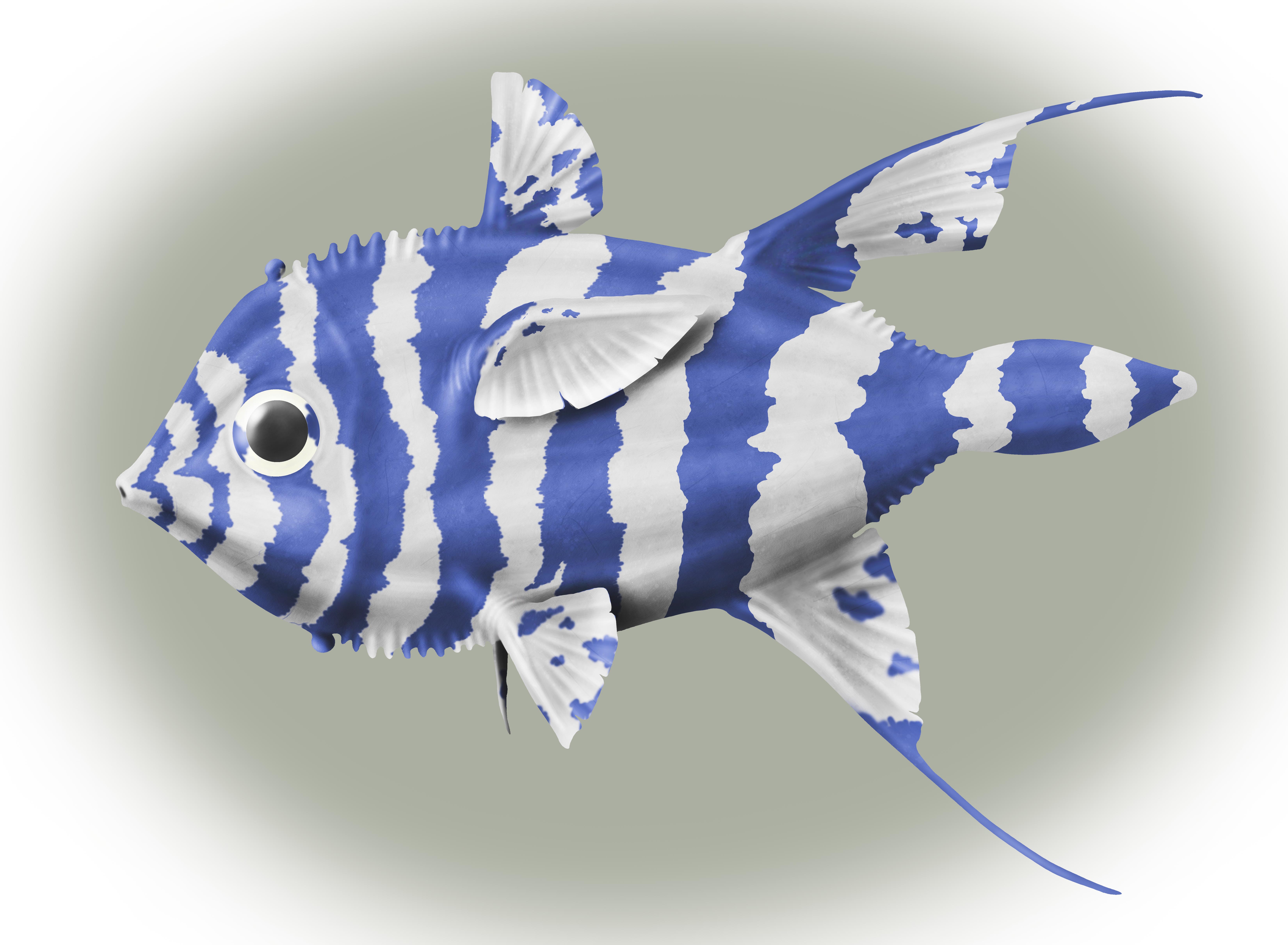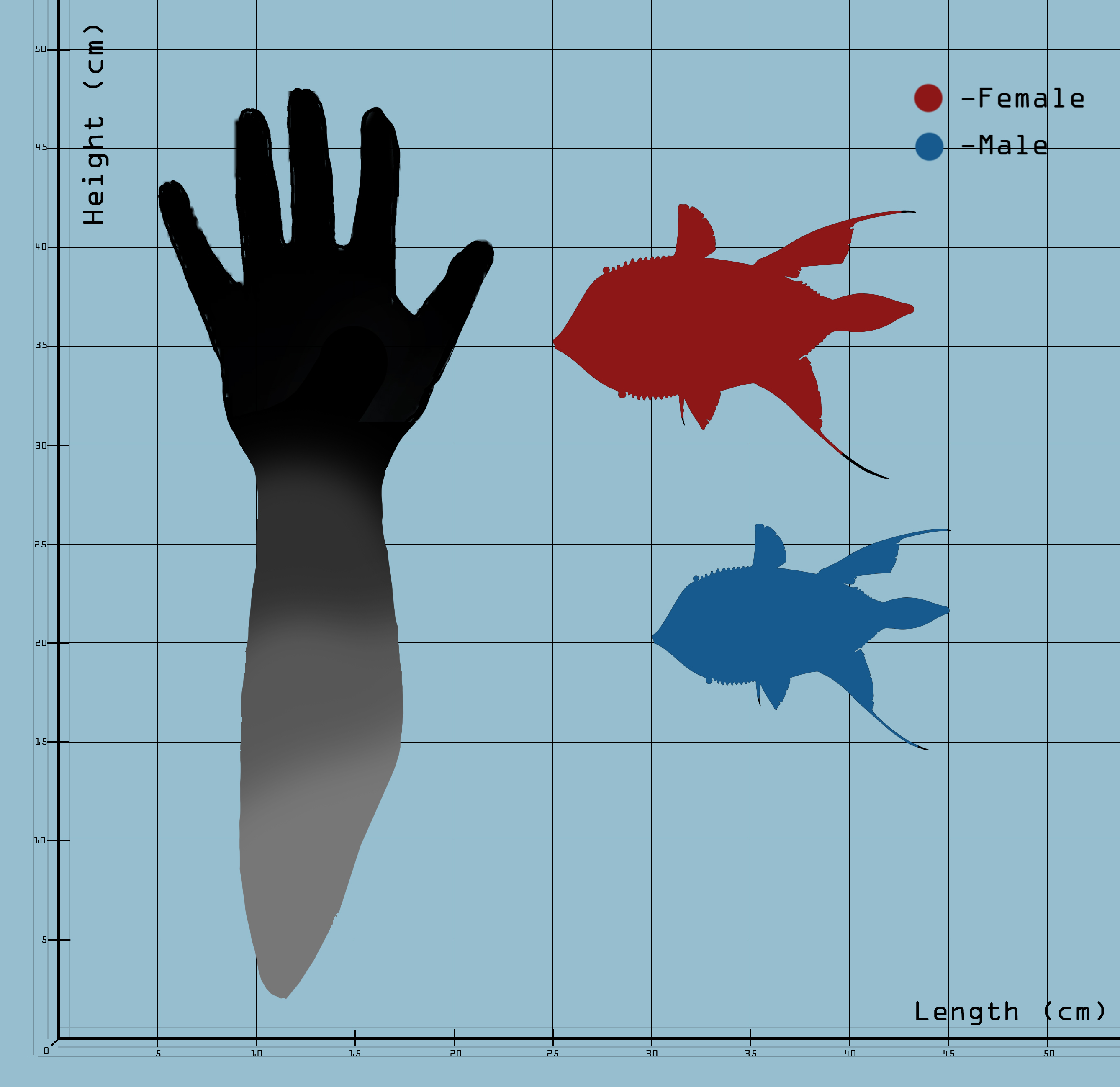White & Blue Kika
Prosilia ballistaeformis is a species of Philloichthyd Coronapinninoid amphibian from the Outer reefs of the Gulf Sea.
The animal lives along the steep cliffside of the fore reef in large shoals of up to seventy specimens, pollinating the sponges that grow along the reef wall.
The bright striping of the body, while mainly used in intraspecific communication and mate selection, is also used by the group to disorient and drive away predators.
On its own, a single specimen will be less visible striped in blue, as the latter will break down its silhouette and make it less probable for a predator to notice it, however, in large shoals, the striping will create disruptive patterns to most predator's eyes, helping avoiding ambushes by wannabe threats.
The specific sponge type these animals pollinate is a kind of massive sponge morphology characterized by hundreds of small holes along its body, which offer a double function.
These entrances lead to the pollen canal the Kika uses to feed and pollinate the plant, while the hole itself is just big enough as to fit the Kika itself, both ensuring the plant is pollinated by the right species of Kika and offering an ideal hiding place for the animal in case they need it, given how their habitat is laking a proper under-reef.
P. ballistaeformis colonies are usually stationed around the same four to five sponges they'll cycle through, rarely venturing far from them when out wandering.
The shoal will also protect their sponges from predation by swarming biodestroyers such as Chalybomaxillae fulmineus, pecking the area around the eye and obstructing its visual in the hope of driving it away.
The local disappearance of large Biodestroyers due to anthropic activity is negativily affecting coral and sponge growth, leading to increased mortality in both its food source and in hatchlings.
While not as popular as its cousin, the Herald Kika, this species is also kept in home aquariums as a curious pet for tropical tanks.
Basic Information
Anatomy
- Stubby snout ending in a very small mouth opening, from which a long prehensile tongue exits.
- Large eyes, head triangular.
- On both the terminal ends of the head there's a small stubby knob-shaped bony growth.
- Ten small serration on the dorsal section of the body from the back of the head to the base of the Dorsal I fin, nine serrations from the end of the second dorsal fin to the base of the Gill Fan.
- Eleven serrations on the ventral surface, from the back of the head to the base of the Anal I fins, seven from the end of the second anal to the base of the Gill Fan.
- Pecotral fin leaf shaped.
- Dorsal and Anal I rounded.
- Dorsal and Anal II subtriangular with long terminal sections; Dorsal II in particular dips deeply in membrane surface area before its end, creating a peculiar geometrical shape.
- Gill Tail short and bottleneck-shaped, ending in a low and long Gill Fan
Genetics and Reproduction
Promiscuous species.
P. ballistaeformis mates during the sponge blossoming season.
Males will enter heat before females do, taking advantage of this headstart to change into the breeding season colouration.
They'll make use of all their agility to try to impress females in small groups.
A group of five males will start courtshipping the same female in a synchronized dance where they'll do their best to avoid her looking away, following her movements and staying in front of her.
During this dance, the leading male will take turns with the assisting ones to impress her, once one of them has showed his colours and agility by quickly strafing sideways in front of her, another one will take its place, doing the same.
If the female starts mirroring the males' movements, then the leading male will move to a belly up position while the assisting ones surround it; if the female moves above him and mirrors that movement too, then the leading male mates with her.
As soon as the mating has ended, the couple will disband and the leading male will cycle onto assisting the next member in line in the small bachelor group in finding a mate.
The female will lay her eggs inside one of the entry canals of the sponge around twenty to thirty minutes later, she'll leave the nest as soon as the lays her eggs in order to mate again.
A single female will try to lay as many egg batches as possible inside a single sponge canal as she'll guard her nest until the young are born.
Growth Rate & Stages
Ontogeny not very visible outside of a transparent colouration at birth.
The natal aculeus is lost while hatching.
Ecology and Habitats
Epipelagic species found living at depths between 20 and 60 m.
Lives along the reef wall near the massive sponges they pollinate, rarely wandering far from them.
Dietary Needs and Habits
Pollinator species that feeds on the nectar of specific sponges it co-evolved along with.
Biological Cycle
Periannial species with no dips in activity year long.
Additional Information
Social Structure
Very social animal that lives in large shoals which will rarely disperse.
They live very close to one another for mutual protection and socialization.
They often groom eachother and communicate vocally and through slight variation in colouration brightness.
Domestication
Popular pet in tropical tanks due to size, colour and friendliness.
They'll need open space and a synthetic wall with plenty of hiding spots for privacy and nesting, as they are quite easy to reproduce in captivity, even in home aquariums.
They accept both Bottled nectar and, if trained, algal paste; the latter one is not reccomanded as it reduces their lifespan due to it not being their natural diet while also making their colouration dimmer to the point of bleaching of the stripes.
Can be found in the market in a few variaties, among the most popular are Ghost white and Kika Blast.
Uses, Products & Exploitation
Of noticeable impact in the pet trade due to its relative popularity.
Of modest economic importance for tourism, although their habitat is a bit harder to reach both because of its position and because of the presence of possibly dangerous biodestroyers in the area.
Perception and Sensory Capabilities
Very good eyesight, exceptional sense of smell.
Symbiotic and Parasitic organisms
Afflicted by small drinker worms and eye parasites.
In a mutualistic relationship with massive-type sponges.
They'll pollinate them in exchange for food and mutual protection from predation.
Scientific Name
Eoichthyia; Hijerakia; Parahijerakida; Coronapinninoidea; Philloichthydae ; Prosilia; P. ballistaeformis
Lifespan
4 Years
Conservation Status
Least Concern: although the disappearance of Biodestroyers is harming local populations, the species is still abundant enough as to not be considered threatened; no measures underway to protect the species.
Population Trend: DECLINE
Average Weight
60-200 gr
Body Tint, Colouring and Marking
Body white striped with large vertical blue bands.
Fins dotted in blue, marking unique to every specimen.
Eye crossed by a single horizontal blue band.
Remove these ads. Join the Worldbuilders Guild












Comments